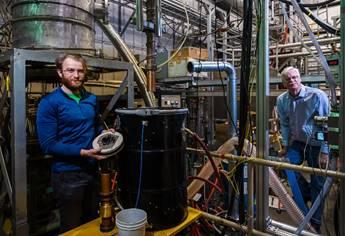
Fostering curiosity in our endeavors
I believe that a key aspect of my role as your leader is to create an atmosphere that encourages curiosity. When we create a workplace culture focused on respect, diversity, and inclusivity, we open the pathway for curiosity to take root and flourish. For many of us, this is what drew us to careers in science and engineering in the first place. In this issue of Connections, we highlight two areas of research that demonstrate the outgrowths of curiosity in our directorate. As you read this issue, remember to share any ideas you have for future content with Connections writer Amy Reed (reedac@ornl.gov).
—Kathy McCarthy, Associate Laboratory Director, February/March 2022
Fission research propels space exploration
Many of us are familiar with the role of ORNL’s isotope program in restarting the nation’s domestic production of plutonium-238 for fueling space missions for NASA (National Aeronautics and Space Administration). This includes providing the fuel for the Perseverance rover in NASA’s Mars 2020 mission as well as its upcoming 2027 Dragonfly mission to explore Titan, Saturn’s largest moon.
Perhaps lesser known is the work of engineers and scientists who are applying their nuclear energy expertise to advance space exploration.
Hooked as a college student on the idea of using his nuclear engineering degree to support space missions, Michael B. Smith, in the Advanced Nuclear System Safety and Licensing Group, has applied his expertise in modeling radiation and nuclear processes for several space missions.
“As a nuclear engineer, the same tools that I use to perform terrestrial nuclear engineering tasks and modeling can also be used to model those same phenomena in space to support NASA missions,” Smith said. His work includes modeling galactic cosmic rays, trapped radiation belts, and solar particle events to predict deleterious effects to astronauts, materials, and electronics in deep space environments.
Another FFESD engineer applying her skillset to space exploration projects is Dianne Bull Ezell, Nuclear and Extreme Environment Measurement Group Leader. She is currently developing a high-temperature irradiation test bed for fuels and instrumentation being advanced for future space missions.
Jorge Navarro, in the Advanced Nuclear System Safety and Licensing Group, is the current chair of the Aerospace Nuclear Science and Technology Division of the American Nuclear Society.
“When you realize that what you are developing for use here on the earth can be used also to help take humans into outer space, it sparks something inside of you,” Navarro said.

Fusion R&D advances geothermal clean energy
Researchers are exploring how to repurpose gyrotron technology, used to heat plasmas in fusion energy experiments, for a new application in the geothermal energy industry.
“If we are successful, this technology will allow power plants across the United States in any geographic area to produce electricity using geothermal steam, a carbon-free clean energy resource,” said Tim Bigelow, a scientist in the Fusion Technology Group. “Currently, geothermal energy is not widely used because it isn’t cost-effective in most regions using conventional drilling methods. This technology would change that.”
Called the Millimeter Wave Drilling System, this technology was spawned at the Massachusetts Institute of Technology’s Plasma Science and Fusion Center and is being commercialized by Quaise Energy, a start-up clean energy company. Quaise is developing a technique using a gyrotron to produce high-power electromagnetic energy that enables drilling to deeper depths and at higher subterranean temperatures. This approach could tap into geothermal resources that currently are considered inaccessible using conventional methods. The end goal of the company is to enable existing power plants currently fueled by fossil fuels, such as coal, to be converted to run on carbon-free geothermal energy to help meet the nation’s emissions goals.
The U.S. Department of Energy’s Advanced Research Projects Agency-Energy (ARPA-E) is funding the project. By working with ORNL fusion researchers, Quaise will tackle technical challenges such as electrical arcing that need to be resolved before the technology can be deployed.
“We sought ORNL as a partner to develop this technology because of its gyrotron equipment and expertise from fusion research that our company needs to take the experiments to the next level,” said Matthew Houde, a co-founder of Quaise Energy.
The research being undertaken to advance this project from the lab to application in the field is tackling technical challenges that will, in turn, help advance fusion research experiments.
“In the end, there will be a feedback loop as we apply what we learn from developing this geothermal energy technology to our fusion research,” Bigelow said. “In essence, we are advancing the forefront of two avenues toward the same goal of carbon-free energy."

